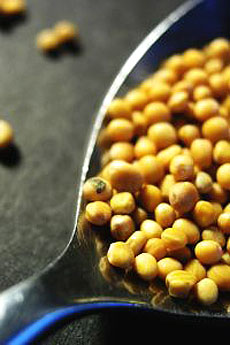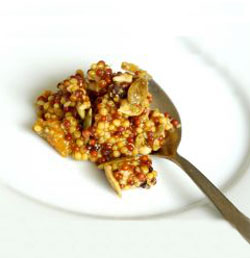

These mustard seeds aren’t spicy until they are cracked and mixed with a liquid—generally wine or vinegar. Photo of mustard seeds by Magda Skale | SXC.
|
VICTORIA MARSHMAN is an intern at THE NIBBLE.
|
|
August 2007
Updated July 2009
|
 |
The History Of Mustard
Page 1: Mustard Facts
CAPSULE REPORT: Mustard is an ancient condiment. Although it wasn’t the Romans’ favorite (they preferred a fermented fish sauce), wealthy Romans made mustard fresh at the dinner table, by grinding the seeds on their plates. The monks of Gaul raised mustard making to an art, and Dijon became the mustard epicenter because a mustard-loving Pope needed a sinecure for his lazy nephew. There’s a National Mustard Day—August 4th—but with the hundreds of different types of mustard available, most at just five or ten calories a tablespoon, it should be enjoyed every day of the year. This is Page 1 of a four-page article. Click on the black links below to visit other pages.
Mustard Overview
The origins of mustard are lost to history, but it is a Northern Hemisphere plant, the seeds of which have been found in Stone Age settlements. Egyptians tossed the seeds onto their food, and sent King Tut to the great beyond with a goodly supply in his tomb. The Sumerians ground it into a paste and mixed it with verjus, the juice of unriped grapes. Wealthy Romans ground it and mixed it with wine at the table. Cultivated for thousands of years, mustard was the primary spice known to Europeans before the advent of the Asian spice trade: Westerners had mustard long before pepper, which originated in India. Once trade routes were established, ancient people from India to Egypt to Rome chewed mustard seeds with their meat for seasoning.
Our word mustard comes from the Middle English mustarde, meaning condiment; which in turn comes from the Old French mostarde. Mosto derives from the Latin mustum, the word for grape must, or young, unfermented wine, which was the liquid mixed with ground mustard seed by French monks who made the condiment. (Today, white wine and verjus, the juice of unripe grapes, are used to make several varieties of mustard; various vinegars are used to make most others.) The monk’s word for mustard was mustum ardens, meaning “burning wine.”
The Mustard Plant
There are about 40 species of mustard plants. The ones used to make the commercial mustard products are the black, brown and white mustard. White mustard, which originated in the Mediterranean basin, is what largely ends up as bright yellow hot dog mustard; brown mustard, which originated in the Himalayas, is the basic Chinese restaurant mustard served in America and the basis for most American and European mustards; and black mustard is popular in the Middle East and Asia Minor, where it originated (it needs to be hand-harvested, so isn’t used much in the West). The mustard plant is in the same family as broccoli, Brussels sprouts, collard, kale and kohlrabi.
The condiment is made from the tiny seeds of the plant, which do not become pungent until they are cracked and mixed with a liquid. It is sold in powder form or already mixed as a paste (when it is properly called prepared mustard). All parts of the mustard plant are edible: The leaves of the plant, known as mustard greens, are delicious in salads when they are young and tender. Older leaves with stems may be eaten fresh as a vegetable. Mustard greens are often cooked with ham or salt pork, and are used in soups and stews. The mustard seeds are also used to make an aromatic oil, and the flowers can be enjoyed as edible decorations.
|
 |

Here, the mustard seeds have been cracked, exposing the brown kernel inside, and mixed with vinegar to create spicy, “whole grain” mustard. Photo by Dominic Morel | SXC.
|
Not only tasty, the mustard plant also has significant health benefits. Mustard seeds contain nutrients called isothiocyanates that have been shown to prevent the growth of cancer cells, particularly with regards to stomach and colon cancer. The seeds also contain selenium, which reduces the severity of asthma and rheumatoid arthritis, and magnesium, which may reduce high blood pressure and the frequency of migraines.
Continue To Page 2: The History Of Mustard
Return To The Article Index Above

|





